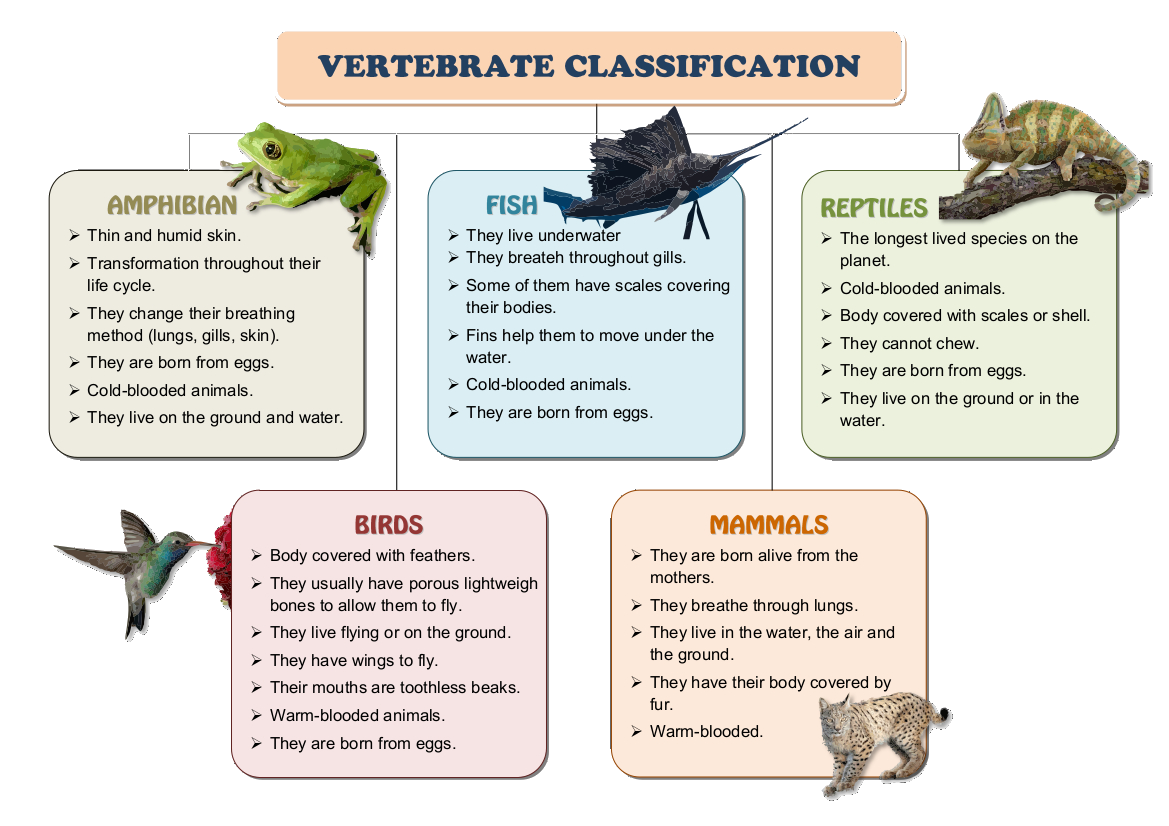Vertebrates – Diversity, Evolution, Classification, and Reproduction Study Guide
Introduction
A vertebrate is an animal from the Vertebrate Subphylum and the Chordate Phylum. They are characterized by a muscular system and have backbones. They are among the most recognizable organisms and species in the animal kingdom. There are about 6200 – 6500 diverse vertebrates discovered to date. They are also one of the most dominant terrestrial animals for billions and billions of years. The subphylum of vertebrates represents an overwhelming and vast majority of the parent phylum chordata.
What are vertebrates?
Any animal species with a backbone extending entirely at the back of the body and possessing a skeleton are referred to as the vertebrates and belong to the subphylum of vertebrata. They also include human beings. When we think about the term vertebrates, we tend to think about bones.
What distinguishes vertebrates from other animals is that they possess a spinal or a vertebral column.
- These include mammals, birds, reptiles, amphibians, and fishes.
- A bone-in these animal species helps protect the spinal cord and provides shape and support to the body.
- These animals are also characterized by a muscular system consisting primarily of bilaterally paired masses and a central nervous system partly enclosed within the backbone.
Evolution of the Vertebrates
The earliest vertebrates originated about 500 to 600 million years ago during the Cambrian explosion. They were jawless fish, and they did not have a vertebral column but had a cranium to protect the brain. The amphibians, mammals, reptiles, birds, etc., evolved after the fishes. These groups initially had a basic vertebrate body comprising a notochord, vertebrate, and a well-defined head and tail.
Classification of Vertebrates
The class of vertebrates is classified into 7 classes based on their physical and anatomical structures:
1. Class Aves: They are characterized based on feathers, toothless beaks, and a high metabolic rate. They also lay hard-shelled eggs.
2. Class Mammalia: This set of organisms can regulate their body temperature irrespective of the surrounding temperature. They are endothermic animals, and this class includes human beings and platypuses.
3. Class Amphibia: This class includes ectothermic amphibians such as frogs, salamanders, etc. Most amphibians need water as their breeding grounds as they lay shell-less eggs. This way, the young ones transform from fully aquatic larval forms to fully terrestrial forms.
4. Class Reptilia: Ectothermic tetrapods like snakes, turtles, crocodiles, etc.
5. Class Osteichthyes: This is characterized by a skeleton made of bones. They are also known to be the largest class of vertebrates today.
6. Class Chondrichthyes: This class is characterized by cartilages instead of bones in their skeleton. They include sharks, skates, rays, sawfish, etc.
7. Class Agnatha: They are very primitive and jawless fishes with circular mouths. This class mostly consists of scavengers and parasites.
Reproduction in Vertebrates
The vertebrates reproduce sexually, and most of them have seperate male and female sexes present. Vertebrates follow one of these 3 types of reproduction types:
1. Vivipary: It is the development of an embryo inside the parent’s body. This type of mechanism produces the young ones instead of laying eggs. e.g., human beings, dogs, cats, elephants, etc
2. Ovipary: Here, the female animal lays eggs with little or no embryonic development within the mother, and the mother provides no nourishment to the developing embryo inside the egg.E.g., Most fish. amphibians, reptiles, etc
3. Ovovivipary: These animals lay eggs and develop the eggs inside the other’s womb or body. The eggs are hatched inside the mother, reproducing her young ones. E.g., sharks, rays, snakes, some insects, etc
Conclusion:
- A stiff vertebral column or notochord running through the animal’s length.
- Humans and most vertebrates possess a notochord as an embryo, ultimately developing into a vertebral column.
- Many nerves run above the notochord, and the alimentary canal runs below it.
- The alimentary canal ends at the anus, the posterior part, and opens to the body’s exterior. The tail region extends after the anus region.
- The mouth is generally present in the animals’ anterior part or right below it.
- Their bodies are multicellular.
- They are generally heterotrophs.
- Their major functions are obtaining food for energy and oxygen to breathe, keeping their internal conditions in balance, and moving and reproducing.
FAQs:
1. What are the 5 classifications of vertebrates?
The five classifications of vertebrates are: Class Amphibia, Class Mammalia, Class Aves, Class Reptilia, Class Fishes
2. What are the 4 major characteristics of vertebrate subphylum?
The 4 major characteristics of vertebrate subphylum are:
- A vertebral column or a notochord
- The brain covered in a cranium
- Pharyngeal slits that connect the pharynx, which links the mouth cavity and esophagus with the outside
- A semi-open circulatory system
3. How are vertebrates classified into different groups?
Vertebrates are classified based on anatomical and physical criteria such as an exoskeleton, respiratory organs, method of giving birth, mode of living, etc.
4. What are vertebrates? Give two examples?
Vertebrates have a spine, or backbone, made of multiple disc-shaped bones called vertebrae. There are five classes of vertebrates: amphibians, fish, reptiles, birds, and mammals. Examples include frogs, tuna.
We hope you enjoyed studying this lesson and learned something cool while studying Vertebrates! Join our discord community to get any questions you may have answered and to engage with other students just like you. Don’t forget to download our App to experience our fun, VR classrooms – we promise, it makes studying much more fun!😎
Sources:
- Vertebrate Diversityhttps://flexbooks.ck12.org/cbook/ck-12-biology-flexbook-2.0/section/12.2/primary/lesson/vertebrate-characteristics-bio/ Accessed on 3 Dec 2021.
- Vertebrate Classificationhttps://flexbooks.ck12.org/cbook/ck-12-biology-flexbook-2.0/section/12.4/primary/lesson/vertebrate-classification-bio/ Accessed on 3 Dec 2021
- Vertebrate Reproductionhttps://flexbooks.ck12.org/cbook/ck-12-biology-flexbook-2.0/section/12.3/primary/lesson/vertebrate-reproduction-bio/ Accessed on 3 Dec 2021
- Vertebrate https://en.wikipedia.org/wiki/Vertebrate Accessed on 3 Dec 2021
- Vertebrate https://www.britannica.com/animal/vertebrate Accessed on 3 Dec 2021


